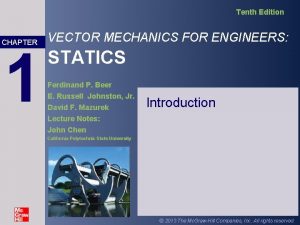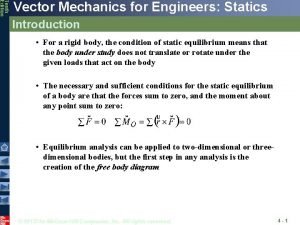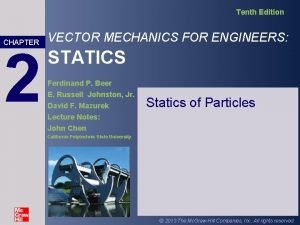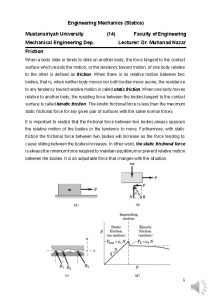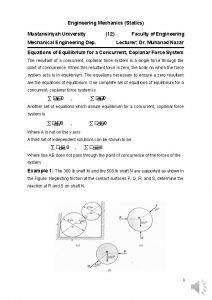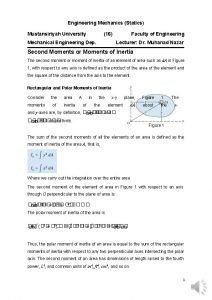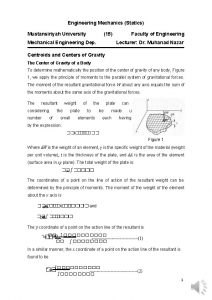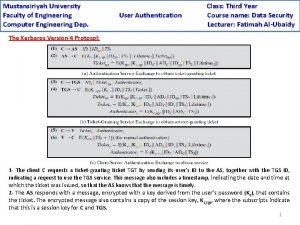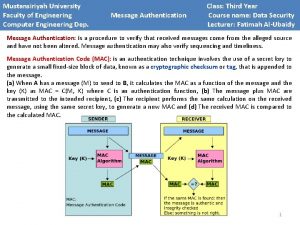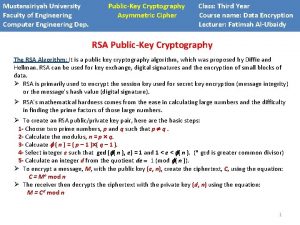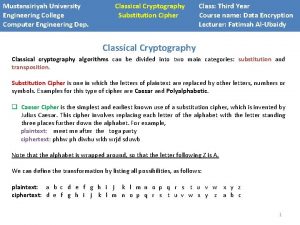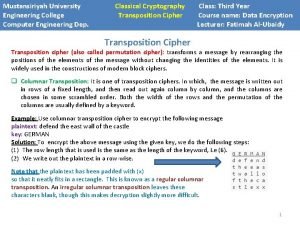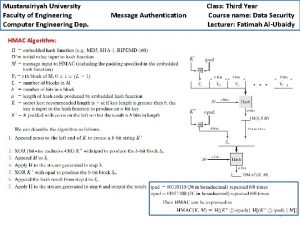Engineering Mechanics Statics Mustansiriyah University Mechanical Engineering Dep















- Slides: 15

Engineering Mechanics (Statics) Mustansiriyah University Mechanical Engineering Dep. (11) Faculty of Engineering Lecturer: Dr. Muhanad Nazar Equilibrium When a system of forces acting on a body has no resultant, the body on which the force system acts is in equilibrium. Newton’s first law of motion states that if the resultant force acting on a particle is zero, the particle will remain at rest or move with a constant velocity. The resultant of each type of force system studied was determined by obtaining the sum of the forces of the system in certain directions and the sum of the moments of the forces with respect to certain axes. To study the force system acting upon anybody or any portion of a body, it is first necessary to recognize completely what forces, both known and unknown, act on the body. Free-Body Diagrams (FBD): A free body diagram is a sketch of a body, a portion of a body, or to two or more bodies completely isolated or free from all other bodies, showing the forces exerted by all other bodies on the one being considered. Before presenting a formal procedure as to how to draw a free-body diagram, we will first consider the various types of reactions that occur at supports and points of contact between bodies subjected to coplanar force systems. As a general rule, 1

2

3

4

Procedure for Analysis To construct a free-body diagram for a rigid body or any group of bodies considered as a single system, the following steps should be performed: Draw Outlined Shape. Imagine the body to be isolated or cut “free” from its constraints and connections and draw (sketch) its outlined shape. Show All Forces and Couple Moments. Identify all the known and unknown external forces and couple moments that act on the body. Those generally encountered are due to (1) applied loadings, (2) reactions occurring at the supports or at points of contact with other bodies, and (3) the weight of the body. To account for all these effects, it may help to trace over the boundary, carefully noting each force or couple moment acting on it. Identify each Loading and give Dimensions. The forces and couple moments that are known should be labeled with their proper magnitudes and directions. Letters are used to represent the magnitudes and direction angles of forces and couple moments that are unknown. Finally, indicate the dimensions of the body necessary for calculating the moments of forces. 5

Important Points • No equilibrium problem should be solved without first drawing the free-body diagram, so as to account for all the forces and couple moments that act on the body. • If a support prevents translation of a body in a particular direction, then the support exerts a force on the body in that direction. • If rotation is prevented, then the support exerts a couple moment on the body. Study Tables mentioned above. • Internal forces are never shown on the free-body diagram since they occur in equal but opposite collinear pairs and therefore cancel out. • The weight of a body is an external force, and its effect is represented by a single resultant force acting through the body’s center of gravity G. • Couple moments can be placed anywhere on the free-body diagram since they are free vectors. Forces can act at any point along their lines of action since they are sliding vectors. Example 1: Draw the free-body diagram of the uniform beam shown in Figure a. The beam has a mass of 100 kg. 6

Solution: The free-body diagram of the beam is shown in Figure b. Since the support at A is fixed, the wall exerts three reactions on the beam, denoted as Ax, Ay, and MA. The magnitudes of these reactions are unknown, and their sense has been assumed. The weight of the beam, W = 100(9. 81) N = 981 N, acts through the beam’s center of gravity G, which is 3 m from A since the beam is uniform. Example 2: Body A weights 200 Ib and the homogeneous bar B weights 40 Ib. Draw a FBD of each of the bodies. 7

Example 3: Create FBD for a whole frame coniting of member AB and CD upport the pulleys, cable, and block L. Example 4: Two smooth pipes, each having a mass of 300 kg, are supported by the forked tines of the tractor in Figure a. Draw the free-body diagrams for each pipe and both pipes together. Solution: 8

The idealized model from which we must draw the free-body diagrams is shown in Figure b. Here the pipes are identified, the dimensions have been added, and the physical situation reduced to its simplest form. The free-body diagram for pipe A is shown in Figure c. Its weight is W = 300(9. 81) N = 2943 N. Assuming all contacting surfaces are smooth , the reactive forces T, F, R act in a direction normal to the tangent at their surfaces of contact. The free-body diagram of pipe B is shown in Figure d. Can you identify each of the three forces acting on this pipe? In particular, note that R, representing the force of A on B, Figure d, is equal and opposite to R representing the force of B on A, Figure c. This is a consequence of Newton’s third law of motion. The free-body diagram of both pipes combined (“system”) is shown in Figure e. Here the contact force R, which acts between A and B, is considered as an internal force and hence is not shown on the free-body diagram. That is, it represents a pair of equal but opposite collinear forces which cancel each other. Equations of Equilibrium: In previous section, we developed the two equations which are both necessary and sufficient for the equilibrium of a rigid body, namely, ΣF = 0 and ΣMO = 0. When the body is subjected to a system of forces, which all lie in the x – y plane, then the forces can be resolved into their x and y components. Consequently, the conditions for equilibrium in two dimensions are: 9

Example 1: Determine the horizontal and vertical components of reaction on the beam caused by the pin at B and the rocker at A as shown. Neglect the weight of the beam. Solution: Free-Body Diagram. Identify each of the forces shown on the free-body diagram of the beam, Figure b, for simplicity, the 600 -N force is represented by its x and y components as shown in Figure b Equations of Equilibrium. Summing forces in the x direction yields: A direct solution for Ay can be obtained by applying the moment equation ΣMB = 0 about point B: 10

Summing forces in the y direction, using this result, gives: Example 2: The cord shown in Figure a supports a force of 100 lb and wraps over the frictionless pulley. Determine the tension in the cord at C and the horizontal and vertical components of reaction at pin A. Solution: Equations of Equilibrium. Summing moments about point A to eliminate Ax and Ay, Figure c, we have: 11

Example 3: The member shown in Figure a is pin connected at A and rests against a smooth support at B. Determine the horizontal and vertical components of reaction at the pin A. Solution: Free-Body Diagram. As shown in Figure b the reaction NB is perpendicular to the member at B. Also, horizontal and vertical components of reaction are represented at A. Equations of Equilibrium. Summing moments about A, we obtain a direct solution for NB, 12

Example 4: The box wrench in Figure a is used to tighten the bolt at A. If the wrench does not turn when the load is applied to the handle, determine the torque or moment applied to the bolt and the force of the wrench on the bolt. Solution: Free-Body Diagram. The free-body diagram for the wrench is shown in Figure b. Since the bolt acts as a “fixed support, ” it exerts force components Ax and Ay and a moment MA on the wrench at A. Equations of Equilibrium. Checking: 13

Example 5: Determine the horizontal and vertical components of reaction on the member at the pin A, and the normal reaction at the roller B in Figure a. Solution: Free-Body Diagram. The free-body diagram is shown in Figure b. The pin at A exerts two components of reaction on the member, Ax and Ay. Equations of Equilibrium. The reaction NB can be obtained directly by summing moments about point A, since Ax and Ay produce no moment about A. 14

Example: Create FBD for the followings 15
 Pearson education south asia pte ltd
Pearson education south asia pte ltd Moment of force engineering mechanics
Moment of force engineering mechanics Static equilibrium
Static equilibrium Vector mechanics for engineers statics 12th
Vector mechanics for engineers statics 12th Vector mechanics for engineers statics 10th edition
Vector mechanics for engineers statics 10th edition Vector mechanics
Vector mechanics Vector mechanics for engineers statics 10th edition
Vector mechanics for engineers statics 10th edition Mechanics for engineers
Mechanics for engineers Yildiz technical university mechanical engineering
Yildiz technical university mechanical engineering San jose state university mechanical engineering
San jose state university mechanical engineering King saud university mechanical engineering
King saud university mechanical engineering Czech technical university mechanical engineering
Czech technical university mechanical engineering American university mechanical engineering
American university mechanical engineering American university mechanical engineering
American university mechanical engineering Yale university mechanical engineering
Yale university mechanical engineering University of florida mechanical engineering
University of florida mechanical engineering




